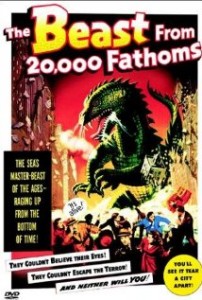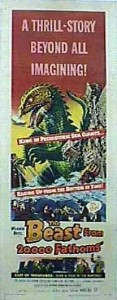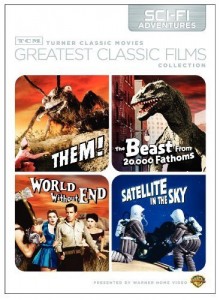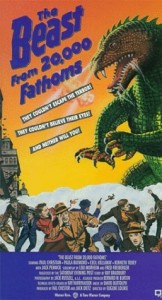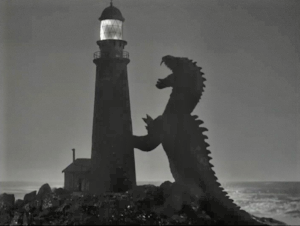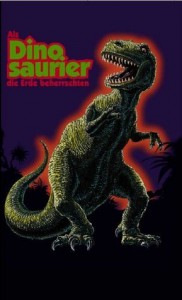The Beast from 20,000 Fathoms *** (1953, Paul Hubschmid, Paula Raymond, Cecil Kellaway, Kenneth Tobey, Lee Van Cleef, Donald Woods, Steve Brodie, Ross Elliott, Jack Pennick) – Classic Movie Review 795
A fictional frozen hibernating prehistoric rhedosaurus – a 200-foot carnivorous dinosaur with four legs – is thawed out in the Arctic Circle by an atomic bomb test and is spotted by physicist Professor Tom Nesbitt, in director Eugène Lourié’s fondly regarded 1953 American sci-fi adventure monster movie, The Beast from 20,000 Fathoms. Nesbitt is the only surviving witness to The Beast’s awakening and is dismissed as being delirious at the time.
The film stars Paul Christian (aka Paul Hubschmid) as Professor Tom Nesbitt, Paula Raymond, Cecil Kellaway, and Kenneth Tobey. It is notable for its special effects by Ray Harryhausen and its partial screenplay basis in Ray Bradbury’s 1951 short story The Fog Horn. And notable for its prophetic dire warning, as Nesbitt advises: ‘What the cumulative effects of all these atomic explosions and tests will be, only time will tell.’
The monster wreaks havoc and destruction as it travels south, arriving in New York City, its ancestral home, where it fights back when it is studied in a diving bell, hoving up for a rampage in Manhattan before the film’s climax at Coney Island. These roller coaster live-action scenes are filmed at the Pike in Long Beach, California, and show the Cyclone Racer entrance ramp, ticket booth, loading platform and beach views of the coaster.
On the plus side, The Beast from 20,000 Fathoms can boast stout-hearted turns from Cecil Kellaway as palaeontologist Dr Thurgood Elson, Paula Raymond as his assistant Lee Hunter, Kenneth Tobey as Colonel Jack Evans and Lee Van Cleef in a bit role as Corporal Stone, the sharpshooter.
These performances, plus the entertaining Ray Harryhausen special effects, make up for a skimpy budget and a sometimes unconvincing screenplay, adapted from Ray Bradbury’s 1951 short story The Fog Horn, notably when a lighthouse is destroyed by the prehistoric dinosaur The Beast. The script is afflicted by the usual cheesy dialogue that pervades these old 50s sci-fi movies, which really only adds to the fun.
Eugène Lourié keeps the direction moody and sparky, with the help of Jack Russell’s cleverly-lit cinematography, which includes some city location shooting, which was then a rare luxury.
Also in the cast are Donald Woods, Steve Brodie, Ross Elliott, Jack Pennick and Ray Hyke.
For the roller coaster scenes, Ray Harryhausen’s split-matte, in-camera special effects effectively combine the actors’ live action and the roller coaster background footage from the Pike’s parking lot with the stop-motion animation of the Beast’s destroying a shooting miniature of the roller coaster.
Russian-born French art director and director Eugène Lourié also made The Colossus of New York (1958), The Giant Behemoth (1959) and Gorgo (1961).
The Fog Horn is the first story in Ray Bradbury’s collection book The Golden Apples of the Sun. It was originally published as a short story in The Saturday Evening Post titled The Beast from 20,000 Fathoms and later anthologised under the title The Fog Horn.
A draft script for a film called The Monster from Beneath the Sea was already in preproduction in 1951 when Ray Harryhausen told the producers that Ray Bradbury had just published a short story in The Saturday Evening Post titled The Beast from 20,000 Fathoms about a marine-based prehistoric dinosaur that destroys a lighthouse. A similar scene was in the draft script but the producers wanted to cash in on Bradbury’s popularity and bought the rights and changed the film’s title. Bradbury’s name was used in the promotion campaign and had the on-screen credit ‘Suggested by the Saturday Evening Post Story by Ray Bradbury’.
The Beast from 20,000 Fathoms is one of the early atomic monster movies, inspiring a generation of creature features, especially Godzilla. Lourié’s Gorgo (1961) returned the favour, inspired by Godzilla.
It is made for just $200,000 by Jack Dietz Productions and distributed by Warner Bros.
The score was composed by Michel Michelet, but Warner Bros bought the film and commissioned a powerful new score by David Buttolph, influencing much of the monster movie music of the Fifties.
The artificial dinosaur skeleton in the museum sequence is the one from Bringing Up Baby (1938), borrowed from RKO Pictures’ prop store.
Harryhausen’s monster looks nothing like the short story’s Brontosaurus-type creature, being a Tyrannosaurus-type prehistoric predator, though it has four legs. It is unlike any real carnivorous dinosaur and resembles a rauisuchian.
The budget was $200,000, and it earned $5 million at the box office. Warner Bros paid out $800,000, including a large advertising campaign, and released it on 13 June 1953 in New York and Los Angeles, followed by one of the widest and fastest release of the era.
Original prints were sepia toned.
The cast are Paul Christian as Professor Tom Nesbitt, Paula Raymond as Lee Hunter, Cecil Kellaway as Dr Thurgood Elson, Kenneth Tobey as Colonel Jack Evans, Donald Woods as Captain Phil Jackson, Ross Elliott as George Ritchie, Steve Brodie as Sgt Loomis, Jack Pennick as Jacob Bowman, Michael Fox as ER doctor, Lee Van Cleef as Corporal Jason Stone, Frank Ferguson as Dr Morton, King Donovan as Dr Ingersoll, James Best as radar operator Charlie, and Ray Hyke.
© Derek Winnert 2014 Classic Movie Review 795
Check out more reviews on http://derekwinnert.com

